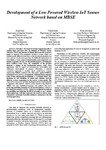Development of a low powered wireless iot sensor network based on mbse
| dc.contributor.author | Taha, J | en |
| dc.contributor.author | Salehi, V | en |
| dc.contributor.author | Abraham, F | en |
| dc.date.accessioned | 2019-04-08T13:51:22Z | |
| dc.date.available | 2019-04-08T13:51:22Z | |
| dc.date.issued | 2018-11-26 | en |
| dc.identifier.isbn | 9781538644461 | en |
| dc.identifier.uri | http://hdl.handle.net/10026.1/13684 | |
| dc.description.abstract |
Nowadays, the trend in System Engineering (SE) is shifting more and more in the domains of Wireless Sensor Networks (WSN) and Internet of Things (IoT) and will reach new height in demand. The complexity of those systems which are fundamentally different from those of the last decades in their own areas and are furthermore growing. To fulfil all requirements in those fields, a wider range of functionalities and components are needed, especially for IoT systems. In the interdisciplinary development, many conflicts occur. Thus, the complexity of the product demands a change of the development process itself. Most approaches lack in aspects of transparency, traceability and continuous development in general. Therefore, a neutral systematic approach is needed, which model-based systems engineering (MBSE) could provide. This paper applied MBSE in the domain of IoT in WSN development. Although MBSE emerged from system engineering/development, it essentially allows any developer in any discipline to understand relations between different system components in the central system model. The stages of this research are not fully developed yet but a high potential is expected. This holistic central system model is described by MBSE with tool, modelling language and method. The most promising modelling language for an interdisciplinary work in a real industrial content is SysML, which will be applied throughout the modelling tool following the RFLP principle of the V-model. These endeavours will then represent our result to show a more transparent continuous traceable solution in comparison with the existing application. | en |
| dc.language.iso | en | en |
| dc.rights | Attribution-NonCommercial-NoDerivatives 4.0 International | en |
| dc.rights | Attribution-NonCommercial-NoDerivatives 4.0 International | en |
| dc.rights | Attribution-NonCommercial-NoDerivatives 4.0 International | en |
| dc.rights | Attribution-NonCommercial-NoDerivatives 4.0 International | en |
| dc.rights | Attribution-NonCommercial-NoDerivatives 4.0 International | en |
| dc.rights | Attribution-NonCommercial-NoDerivatives 4.0 International | en |
| dc.rights.uri | http://creativecommons.org/licenses/by-nc-nd/4.0/ | en |
| dc.rights.uri | http://creativecommons.org/licenses/by-nc-nd/4.0/ | en |
| dc.rights.uri | http://creativecommons.org/licenses/by-nc-nd/4.0/ | en |
| dc.rights.uri | http://creativecommons.org/licenses/by-nc-nd/4.0/ | en |
| dc.rights.uri | http://creativecommons.org/licenses/by-nc-nd/4.0/ | en |
| dc.rights.uri | http://creativecommons.org/licenses/by-nc-nd/4.0/ | en |
| dc.title | Development of a low powered wireless iot sensor network based on mbse | en |
| dc.type | Conference Contribution | |
| plymouth.publication-status | Published | en |
| plymouth.journal | 4th IEEE International Symposium on Systems Engineering, ISSE 2018 - Proceedings | en |
| dc.identifier.doi | 10.1109/SysEng.2018.8544420 | en |
| plymouth.organisational-group | /Plymouth | |
| plymouth.organisational-group | /Plymouth/Faculty of Science and Engineering | |
| plymouth.organisational-group | /Plymouth/Users by role | |
| dc.rights.embargoperiod | Not known | en |
| rioxxterms.versionofrecord | 10.1109/SysEng.2018.8544420 | en |
| rioxxterms.licenseref.uri | http://creativecommons.org/licenses/by-nc-nd/4.0/ | en |
| rioxxterms.type | Conference Paper/Proceeding/Abstract | en |



